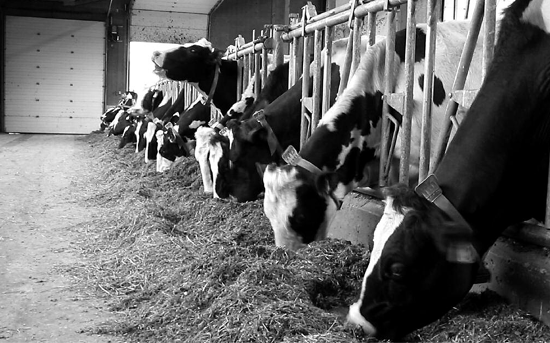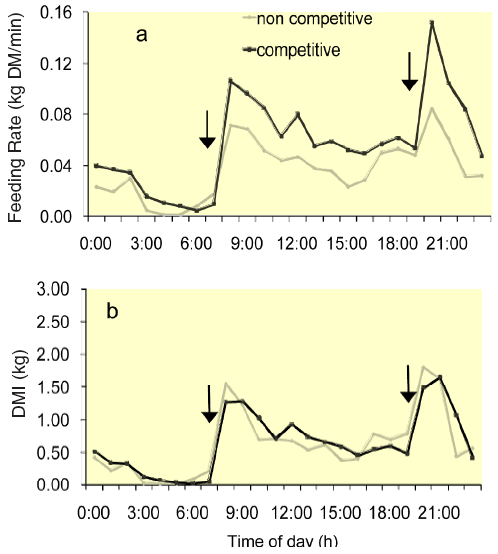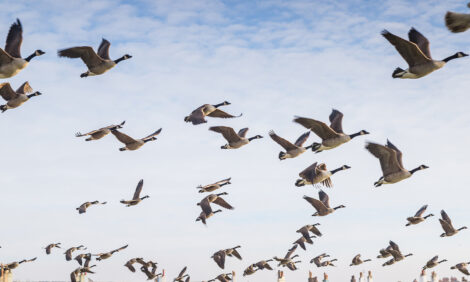



Effects Of Feed Composition And Management
In a total mixed ration (TMR) feeding system, forage and concentrate feed components are combined into a single feed mixture. The objective of this feeding method is to deliver, to each cow, a well-balanced ration that is formulated to maintain health and maximise milk production, say researchers at the University of British Columbia.However, despite our best efforts in formulating and delivering the ration to cows there are indications that the composition of what an individual cow consumes is not the same as what was initially delivered. Dairy cows have been shown to preferentially sort for the smaller grain particles and discriminate against longer forage components. This type of feeding behaviour can lead to cows consuming less fibre and more concentrate than expected. As result, these cows experience lower rumen pH, putting them at greater risk for sub acute ruminal acidosis (SARA).

Figure 1. cows eating and sorting their TMR.
One of the most critical time periods during which dairy cattle experience SARA is in early lactation, in the weeks following calving. During this time cows experience a dramatic change in ration as they are switched from a high forage close-up ration fed before calving to a much lower forage lactation ration after calving. Until recently, we did not know what effect this dietary change had on the feed sorting behaviour by cows.
We therefore set out to determine whether the forage concentration of a ration influences feed sorting by cows and whether the extent of this sorting changes as the cows adapt to a new ration.
In our study six lactating Holstein cows, individually fed once per day, were provided each of two rations in a crossover design: 1) higher forage ration (62 per cent forage), and 2) lower forage ration (51 per cent forage) on a dry matter basis. Dry matter intake, feeding and sorting behaviour were monitored for the first 7 days each cow was on each treatment. Sorting was determined by sampling the offered feed and refusals daily for each cow and undertaking particle size analyses using a Penn State Particle Separator. The particle size separator contained two screens (18 and 9 mm) and a bottom pan resulting in three fractions (long, medium and short). Sorting was calculated as the actual intake of each particle size fraction expressed as a percentage of the predicted intake of that fraction.
We found that cows rapidly adjusted their sorting behaviour within one day when their ration was changed. Cows sorted for the shorter concentrate particles and sorted against the longer forage particles to a greater extent when fed the lower forage ration. We also found that when cows were provided a lower forage ration they increased their dry matter intake (22.2 vs. 19.9 kg/d), decreased feeding time (193.3 vs 220.5 min/d), and increased feeding rate (0.15 vs. 0.11 kg/min), particularly during the time period following feed delivery. These findings are of interest as they provide evidence that feeding a lower forage ration may increase the risk of cows succumbing to SARA, particularly during early lactation when dry matter intake is rapidly increasing.
Another major concern with feed sorting is its varied effect in group-fed cows. When cows engage in sorting, the nutritive value of TMR remaining in the feed bunk changes for those cows which eat hours after feed delivery. Our work has shown that subordinate cows do not have primary access to feed when it is delivered. It is likely that these cows end up consuming a ration that is very different than what was originally formulated. In an extreme case cows may consume insufficient nutrients to maintain high milk production.
To test this prediction we completed a study to investigate how feed sorting is affected by competition for feed bunk access. Thirty-six dry Holstein cows, consuming a close-up TMR (31 per cent corn silage, 40 per cent alfalfa hay, 29 per cent concentrate), were assigned to one of two treatments: 1) noncompetitive (1 cow/feed bin) or 2) competitive (2 cows/feed bin). Feeding behaviour, dry matter intake, and sorting behaviour were monitored on four separate days during weeks 2 and 3 before the cows’ expected calving dates.
As seen in the previous study, regardless of treatment, cows sorted against longer forage particles and for the shorter concentrate particles. Interestingly, competition at the feed bunk dramatically increased the feeding rate of cows throughout the day (Figure 2a). Even though time spent feeding was similar (195 min/d), the competitively-fed cows had fewer meals per day, and tended to have larger and longer meals than the non-competitively fed cows. Competition also changed the distribution of DMI over the course of the day (Figure 2b), resulting in higher intakes during the later hours after feed delivery after much of the feed sorting had already occurred.
These results suggest that increased competition at the feed bunk promotes feeding behaviour patterns that will likely increase the between-cow variation in composition of TMR consumed. In other words, the subordinate cow likely is even more vulnerable in competitive situations and may end up consuming a ration very different than what was initially formulated.

Figure 2. Hourly averages for a) feeding rate (kg DMI/min of feeding time) and b) DMI for cows fed competitively or noncompetitively. Arrows indicate fresh feed delivery times.
Overall, it is recommended that producers pay attention to what their cows are eating. Using a forage particle separator to compare the feed offered with what is left at the end of the day can provide an indication of what they are eating. If producers find evidence of feed sorting, they can manage it and its effects by changing dietary composition (increasing ration forage content) and by decreasing feed bunk competition by providing more bunk space.
This report is a summary of two studies published in the Journal of Dairy Science (Hosseinkhani et al. 2008. J. Dairy Sci. 91:1115- 1121and DeVries et al. 2007. J. Dairy Sci. 90:5572-5579). Dr. Trevor DeVries completed his Ph.D. in UBC’s Animal Welfare Program and is now an Assistant Professor with the Department of Animal and Poultry Science, University of Guelph, Kemptville Campus. Dr. Marina (Nina) von Keyserlingk is an Associate Professor in the UBC Animal Welfare Program located in the Faculty of Land and Food Systems. We thank UBC’s Dairy Education and Research Centre. In particular we thank Karen Beauchemin, Doug Veira, Katy Proudfoot, and Ali Hosseinkhani for their participation in these studies. The project was funded by the Westgen Endowment Fund and Investment Agriculture Foundation of British Columbia and through contributions from many other donors: http://www.landfood.ubc.ca/animalwelfare.


